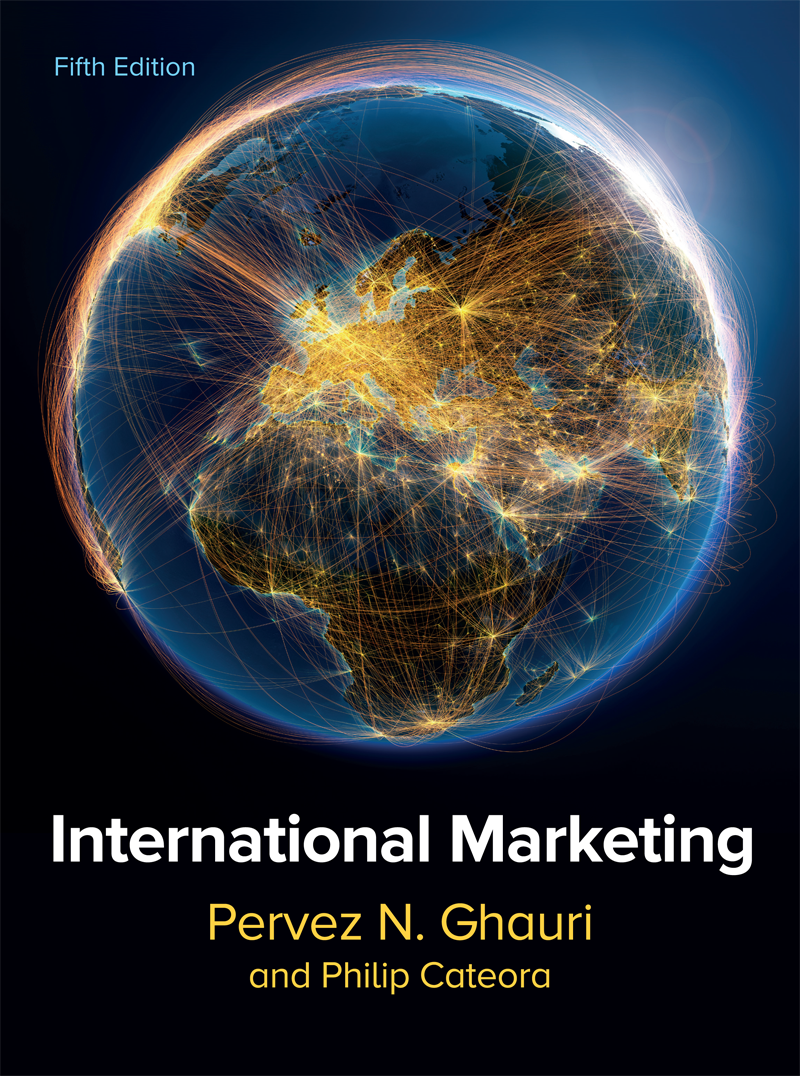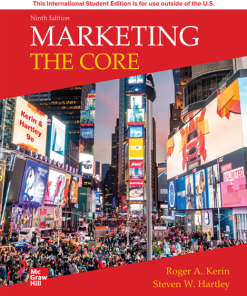(EBook PDF) International Marketing 5th Edition by Pervez Ghauri, Philip Cateora B098X9TG7P full chapters
$50.00 Original price was: $50.00.$25.00Current price is: $25.00.
International Marketing 5th Edition by Pervez Ghauri, Philip Cateora – Ebook PDF Instant Download/DeliveryISBN: B098X9TG7P
Full download International Marketing 5th Edition after payment

Product details:
ISBN-10 : B098X9TG7P
Author: Pervez Ghauri, Philip Cateora
In its 5th edition International Marketing guides students to understand the importance of international marketing for companies of every size and how going international can enhance value and growth. It provides a solid understanding of the key principles and practices of international marketing. The text has been thoroughly updated to reflect the most recent developments in the current business environment and encourages students to critically engage with the content within the context of modern life.
International Marketing 5th Table of contents:
Part 1: An Overview
Chapter 1 The Scope and Challenge of International Marketing
Chapter outline
Chapter learning objectives
The internationalisation of business
International marketing defined
The international marketing task
Marketing controllables
Domestic uncontrollables
Foreign uncontrollables
Environmental adaptations
Self-reference criterion: an obstacle
Different marketing orientations
Domestic market extension orientation
Multi-domestic market orientation
Global marketing orientation
Globalisation of markets
Developing a global awareness
International marketing orientation
Summary
Questions
Further reading
Notes
Chapter 2 The Dynamics of International Markets
Chapter outline
Chapter learning objectives
The twentieth century
World trade and the emergence of multinational corporations
The twenty-first century and beyond
Balance of payments
Protectionism
Protection logic and illogic
Trade barriers
Easing trade restrictions
General Agreement on Tariffs and Trade (GATT)
World Trade Organization (WTO)
International Monetary Fund (IMF)
Summary
Questions
Further reading
Notes
Part 2: The Impact of Culture and Political Systems on International Marketing
Chapter 3 The Foundations of Cultural Understanding
Chapter outline
Chapter learning objectives
Natural features of different international markets
Climate and topography
Nature environment and international trade
Social responsibility and environmental management
Resources
World population trends
World trade routes
Trade routes
Historical perspective in international trade
History and contemporary behaviour
History is subjective
Summary
Questions
Further reading
Notes
Chapter 4 Cultural Dynamics in International Marketing
Chapter outline
Chapter learning objectives
Cultural knowledge
Factual knowledge
Interpretive knowledge
Cultural sensitivity and tolerance
Culture and its elements
Elements of culture
Analysis of elements
Can cultural differences be measured?
Cultural change
Cultural borrowing
Similarities: an illusion
Resistance to change
Planned cultural change
Required adaptation
Degree of adaptation
Imperatives, adiaphora and exclusives
Communications emphasis
Summary
Questions
Further reading
Notes
Chapter 5 The International Political and Legal Environment
Chapter outline
Chapter learning objectives
Political environments
Stability of government policies
Nationalism
Political risks
Economic risks
Encouraging foreign investment
Assessing political vulnerability
Politically sensitive products
Forecasting political risk
Reducing political vulnerability
Good corporate citizenship
Strategies to lessen political risk
Legal environments
Bases for legal systems
Legal recourse in resolving international disputes
Conciliation
Arbitration
Litigation
Protection of intellectual property rights: a special problem
Prior use versus registration
International conventions
Commercial law within countries
Legal environment of the EU
The decision-making process
Competition policy
Summary
Questions
Further reading
Notes
Part 3: Assessing International Market Opportunities
Chapter 6 Researching International Markets
Chapter outline
Chapter learning objectives
Breadth and scope of international marketing research
The marketing research process
Defining the problem and establishing research objectives
Developing a research plan
Quantitative and qualitative research
Gathering secondary data
Gathering primary data
Multicultural research: a special problem
Analysing and interpreting research information
Presenting the findings and results
How to organise marketing research
Estimating market demand
Analogy
Income elasticity
Multinational marketing information systems
Summary
Appendix: Sources of secondary data
International organisations
Chambers of commerce
Trade, business and service organisations
US government
Other sources: abstracts, bibliographies and indexes
Questions
Further reading
Notes
Chapter 7 Emerging and Regional Markets
Chapter outline
Chapter learning objectives
What are emerging markets?
Demand and consumption in emerging markets
Marketing in emerging markets
Regional market groups
Why economic union?
Economic factors
Political factors
Geographic proximity
Cultural factors
Patterns of regional cooperation
Regional cooperation groups
Free trade area
Customs union
Common market
Political union
Regional market groups in Europe
Europe
EU structure
EU authority
The Maastricht Treaty and European union
European Economic Area (EEA)
Regional market groups around the globe
The Commonwealth of Independent States (CIS)
The Americas
Asia
Africa
Middle East
Strategic implications for marketing
Opportunities
Market barriers
Ensuring EU market entry
Summary
Questions
Further reading
Notes
Chapter 8 Exporting and Logistics
Chapter outline
Chapter learning objectives
Regulations and restrictions on exporting and importing
Export controls
Import restrictions
Customs-privileged facilities
Foreign trade zones
Export documents
Export declaration
Bill of lading
Commercial invoice
Insurance policy or certificate
Licences
Other
Terms of sale
Letters of credit
Packing and marking
Export shipping
Logistics
The foreign-freight forwarder
Summary
Questions
Further reading
Notes
Part 4: Developing International Marketing Strategies
Chapter 9 International Marketing Strategies
Chapter outline
Chapter learning objectives
International marketing management
Global versus international marketing management
Standardisation versus adaptation
Market-driven versus market-driving strategies
Competition in the global marketplace
Quality and competitive marketing
Cost containment and international sourcing
Collaborative relationships
Relationship marketing
Formulating international marketing strategy
Positioning
Product life cycle and international marketing strategy
Strategic planning
Company objectives and resources
International commitment
The planning process
Summary
Questions
Further reading
Notes
Chapter 10 International Market Entry Strategies
Chapter outline
Chapter learning objectives
Product portfolio, growth and internationalisation
Product portfolio and growth
Becoming international
Phases of international marketing involvement
Changes in international orientation
Market entry objectives
Market opportunity assessment
Market/country selection
Invest
Divest/license
Joint venture
Export
Selective strategy
Market entry strategies
Exporting
Licensing
Franchising
Strategic international alliances
Consortia
Manufacturing
Countertrade
When to choose which strategy
Summary
Questions
Further reading
Notes
Chapter 11 Segmentation and Positioning in International Markets
Chapter outline
Chapter learning objectives
Market segmentation, targeting and positioning
International market segmentation
International market segments
Geographic segmentation
Demographic segmentation
Psychographic segmentation
Behavioural segmentation
Market targeting
International target market strategies
Market positioning
Approaches to positioning
Product characteristics or attributes
Price–quality
Product users
Positioning in international marketing
International positioning strategies
Global consumer culture positioning
Local consumer culture positioning
Foreign consumer culture positioning
Summary
Questions
Further reading
Notes
Chapter 12 International Branding Strategies
Chapter outline
Chapter learning objectives
Introduction to branding
The development of branding
Country-of-origin effect and global brands
Own brands
Brand elements
Functions of brands
Characteristics of brands
Brand management
Brand equity
Branding strategy
Brand strategy
Brand portfolio strategy
Brand architecture
Corporate branding
Branding versus advertising
Corporate identity
Corporate reputation
Summary
Questions
Further reading
Notes
Chapter 13 Digital and Social Media Marketing
Chapter outline
Chapter learning objectives
Digital marketing
Introduction
Digital marketing strategy
The benefits of digital marketing
Digital media channels
A framework for digital marketing
Social media marketing
Social media domains
Social media planning
Summary
Questions
Further reading
Notes
Chapter 14 Ethics and Social Responsibility in International Marketing
Chapter outline
Chapter learning objectives
Ethical environment
Anti-trust: an evolving issue
What is social responsibility?
Analysing ethical issues and social responsibility
Business ethics
Ethics and international marketing
Green marketing
Ethical behaviour in international marketing
Summary
Questions
Further reading
Notes
Part 5: Developing International Marketing Strategies
Chapter 15 Product Decisions for International Markets
Chapter outline
Chapter learning objectives
International markets and product decisions
Products and brands
Products and culture
Innovative products and adaptation
Diffusion of innovations
Degree of newness
Physical or mandatory requirements and adaptation
The product life cycle
The product life cycle and adaptation
Screening products for adaptation
Analysis of characteristics of innovations
Analysis of product components
Quality products
Summary
Questions
Further reading
Notes
Chapter 16 Marketing Industrial Products and Services
Chapter outline
Chapter learning objectives
The industrial product market
Technology and market demand
The volatility of demand in industrial markets
Attributes of product quality
Price–quality relationship
Product design–quality relationship
Service and replacement parts
Universal standards
ISO 9000 certification and Industry 4.0 standards: international standard of quality
Relationship marketing
Promoting industrial products
Industrial trade shows
Marketing services globally
Characteristics of services
Entering international markets
Market environment for business services
Summary
Questions
Further reading
Notes
Chapter 17 International Distribution and Retailing
Chapter outline
Chapter learning objectives
Structure of distribution channels
Supplier-oriented distribution structure
European distribution structure
Distribution structure in the USA
Trends: from traditional to modern channel structures
The Internet
Factors influencing marketing through the Internet
Electronic advertising
Distribution patterns
General patterns
Retailing
Alternative middleman choices
Home-country middlemen
Foreign-country middlemen
Government-affiliated middlemen
Factors affecting choice of channel
Cost
Capital requirement
Control
Coverage
Character
Continuity
Locating, selecting and motivating channel members
Locating middlemen
Selecting middlemen
Motivating middlemen
Terminating middlemen
Controlling middlemen
Summary
Questions
Further reading
Notes
Chapter 18 Pricing for International Markets
Chapter outline
Chapter learning objectives
Pricing policy
Volume and pricing
Parallel imports
Skimming versus penetration pricing
Leasing in international markets
Factors influencing international pricing
Pricing objectives
Price escalation
Approaches to lessening price escalation
Competition
Target customer
Pricing controls
Administered pricing
Price setting by industry groups
International agreements
Predatory pricing
The purpose of predatory pricing
Predatory pricing and price discrimination
Predatory pricing and cross-subsidisation
Disadvantages of predatory pricing
Transfer pricing
Dumping
Countertrade as a pricing tool
Types of countertrade
Western firms and countertrade
Proactive countertrade strategy
Summary
Questions
Further reading
Notes
People also search for International Marketing 5th:
importance of international marketing
arvin international marketing inc
define international marketing
features of international marketing
be international marketing sdn bhd
Tags:
International,Marketing,Pervez Ghauri, Philip Cateora
You may also like…
Business & Economics - Sales & Marketing
Uncategorized
Uncategorized
Business & Economics - Sales & Marketing
International Marketing, 11th Edition by Michael R. Czinkota
Business & Economics - Sales & Marketing
(Ebook PDF) Marketing 5th Edition by Dhruv Grewal, Leby 1259830233 978-1259830235 full chapters
Business & Economics - Sales & Marketing
Business & Economics - Sales & Marketing
Marketing: The Core 9TH Edition (International Edition) Roger A. Kerin












